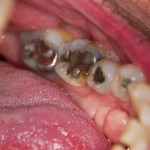
Dental amalgam and composite resin restorations are the most commonly used materials for restoring permanent molar and premolar teeth. Although amalgam is a cost -effective material and has been used for over 150 years its use is decreasing because concerns about their aesthetics and mercury content. The Minamata Convention on Mercury has proposed that the use of dental mercury be phased down and this has been ratified by 127 governments worldwide.
The aim of this Cochrane review update was to examine the efficacy and safety of direct composite fillings versus amalgam fillings.
Methods
Searches were conducted in the Cochrane Oral Health Trials Register, Cochrane Central Register of Controlled Trials (CENTRAL), Medline, Embase, LILACS BIREME, ClinicalTrials.gov and the World Health Organization International Clinical Trials Registry Platform. A supplementary search was undertaken on safety. Randomised controlled trials (RCTs) comparing dental composite resin with dental amalgam restorations in permanent posterior teeth with a follow up period of at least 3 years were considered. For safety outcomes, RCTS and non-RCTs studies were considered. Two reviewers independently screened studies and abstracts. One review extracted data with a second reviewer verifying. Two reviewers independently conducted risk of bias assessments using the Cochrane risk of bias tool. Analyses followed standard Cochrane methodology.
Results
- 8 studies (2 parallel, 6 split-mouth design) were included.
- All the studies were considered to be at high risk of bias.
- Meta-analyses of the 2 parallel-group trials (1645 composite 1365 amalgam restorations in 921 children) found that composite resin restorations had: –
- almost double the risk of failure compared to amalgam restorations, Risk ratio (RR) = 1.89 (95%CI; 1.52 to 2.35) [Low certainty evidence].
- were at much higher risk of secondary caries, RR = 2.14 (95%CI; 1.67 to 2.74) [Low certainty evidence].
- were not more likely to have restoration fracture, RR = 0.87 (95%CI; 0.46 to 1.64) [Low certainty evidence].
- The 6 split-mouth were analysed separately because of poor reliability but their findings were consistent with the results of the parallel-group studies.
- 3 trials investigated possible harms of dental restorations with 2 trials reporting higher urinary mercury levels in children with amalgam restorations, but these were lower than what is known to be toxic.
- Some differences between amalgam and composite resin groups were observed on certain measures of renal, neuropsychological, and psychosocial function, physical development, and postoperative sensitivity; however, no consistent or clinically important harms were found. The vast number of comparisons made false-positive results likely.
- There was no evidence of differences between the amalgam and composite resin groups in neurological symptoms, immune function, and urinary porphyrin excretion. The evidence is of very low certainty, with most harms outcomes reported in only one trial.
Conclusions
The authors concluded: –
Low‐certainty evidence suggests that composite resin restorations may have almost double the failure rate of amalgam restorations. The risk of restoration fracture does not seem to be higher with composite resin restorations, but there is a much higher risk of developing secondary caries. Very low‐certainty evidence suggests that there may be no clinically important differences in the safety profile of amalgam compared with composite resin dental restorations.
This review supports the utility of amalgam restorations, and the results may be particularly useful in parts of the world where amalgam is still the material of choice to restore posterior teeth with proximal caries. Of note, however, is that composite resin materials have undergone important improvements in the years since the trials informing the primary analyses for this review were conducted. The global phase‐down of dental amalgam via the Minamata Convention on Mercury is an important consideration when deciding between amalgam and composite resin dental materials. The choice of which dental material to use will depend on shared decision‐making between dental providers and patients in the clinic setting, and local directives and protocols.
Comments
This Cochrane review is an update of an earlier review published in 2014 (Dental Elf – 7th Apr 2014) with the collaboration of the Canadian Agency for Drugs and Technologies in Health (CADTH). and included one additional trial. As the author’s point out all the included trials were conducted more than 10 years ago and dental materials are constantly evolving so the review may not reflect currently available materials. The review does suggest higher failure rates with composite restorations, so more research is needed to demonstrate long term effectiveness and safety of the latest generation of non-mercury based alternative restorative materials. However as caries is preventable greater emphasis on preventative and minimal restorative approaches will also be important as we move away from mercury based materials.
Links
Primary Paper
Worthington HV, Khangura S, Seal K, Mierzwinski-Urban M, Veitz-Keenan A, Sahrmann P, Schmidlin PR, Davis D, Iheozor-Ejiofor Z, Rasines Alcaraz MG. Direct composite resin fillings versus amalgam fillings for permanent posterior teeth. Cochrane Database of Systematic Reviews 2021, Issue 8. Art. No.: CD005620.
DOI: 10.1002/14651858.CD005620.pub3.
Other references
Cochrane Oral Health Blog: Restoring the back teeth: amalgam versus resin composite fillings
Dental Elf – 7th Apr 2014
Amalgam still an effective filling material for posterior teeth
